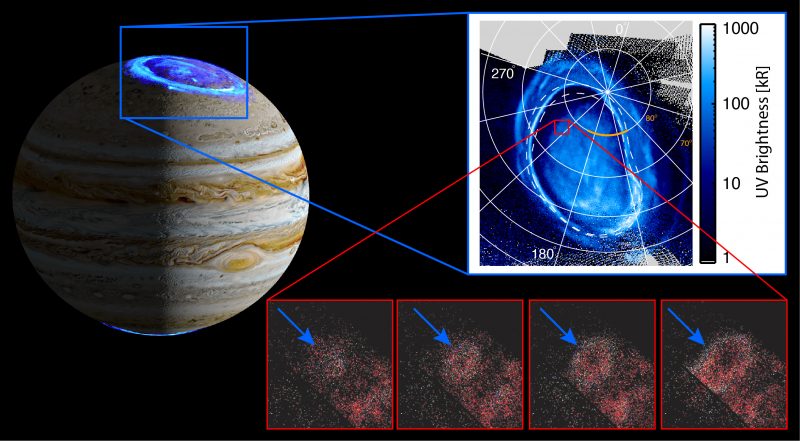
Scientists from the Southwest Research Institute (SwRI) based in San Antonio, Texas, said on March 29, 2021, that they’ve successfully used the Juno spacecraft to discover never-before-seen features associated with Jupiter’s aurora. They called them:
… faint ring-like aurora features … expanding rapidly over time.
The expanding rings are about 1,200 miles (2,000 km) across, and they race outward at speeds of approximately 3 miles (5 km) a second.

These rings, bright in ultraviolet light, appear to have a different origin from other auroral features on Jupiter, which are generated by internal processes, that is, via the motion of charged particles within Jupiter’s massive magnetosphere. These scientists’ statement explained:
Both Jupiter and Earth have magnetic fields that provide protection from the solar wind. The stronger the magnetic field, the larger the magnetosphere. Jupiter’s magnetic field is 20,000 times stronger than Earth’s and creates a magnetosphere so large it begins to deflect the solar wind 2-4 million miles before it reaches Jupiter.
An instrument on Juno called the Ultraviolet Spectrograph captured the newly discovered auroral features, which, unlike the rest of Jupiter’s aurora, are thought to originate near the edge of the planet’s magnetosphere, where the magnetosphere brushes up against the solar wind, a stream of charged particles from the sun. Vincent Hue of SwRI led the study, which was published on March 9, 2021, in the peer-reviewed Journal of Geophysical Research. Hue said:
We think these newly discovered faint ultraviolet features originate millions of miles away from Jupiter, near the Jovian magnetosphere’s boundary with the solar wind. The solar wind is a supersonic stream of charged particles emitted by the sun. When they reach Jupiter, they interact with its magnetosphere in a way that is still not well understood.

How might these new auroral features – these rapidly expanding rings of emission – be generated? These scientists said that:
… in the outer part of the Jovian magnetosphere, near its boundary with the solar wind, plasma from the solar wind often interacts with the Jovian plasma in a way that is thought to form what are called Kelvin-Helmholtz instabilities. These phenomena occur when there are shear velocities, such as at the interface between two fluids moving at different speeds.
Another possible sun-related mechanism to create these emission rings is an event in Jupiter’s magnetosphere called magnetic reconnection. You may have heard of magnetic reconnection happening on the sun, when magnetic field lines twist or cross, making new links, while the disconnected plasma is then freed and can shoot outward in a large flare or ejection that may eventually interact with Earth and cause auroras. Just as with Earth, as the solar wind reaches Jupiter, the Jovian magnetic field can then connect with the solar wind, rearranging and reconnecting to trigger auroras. This type of event is called a dayside magnetic reconnection.
Both processes – the possible Kelvin-Helmholtz instabilities and the possible dayside magnetic reconnection events – are thought to be able to generate particle beams that could travel along the Jovian magnetic field lines, to eventually precipitate and trigger the ring auroras on Jupiter.
Hue commented:
Although this study does not conclude what processes produce these features, the Juno extended mission will allow us to capture and study more of these faint transient events.


Bottom line: NASA’s Juno spacecraft, in orbit around Jupiter, took ultraviolet images of the giant planet and discovered a rapidly expanding auroral ring at the very fringes of the Jovian magnetosphere.











